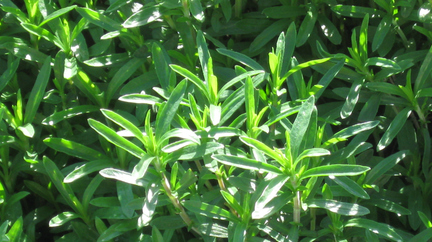Diane 'Princess Di' Winslow, the Martha Stewart of Manchaca, is
getting a little frustrated. For decades she has lovingly cultivated
winter savory plants to pass on to her nursery customers through-
out the area, but for some reason, the buying public has snubbed
the herb.
If those same folks could taste a bowl of Di’s Great Northern beans
(recipe below) flavored with winter savory, they would be as sold
as the International Herb Society, which has chosen Savory as Herb
of the Year for 2015.
Winter savory, AKA mountain savory, or white thyme (Satureja mont-
ana) is a xeric, perennial herb that is easily cultivated in Central Texas.
Growing a foot tall on an evergreen mounding plant, it blooms summer
o late summer with spikes of white to lilac flowers, with purple spots
on the bottom lip, preferring a haircut after it blooms.
It requires full sun and needs excellent drainage, doing better in stony
soil than rich beds. Winter savory is first cousin to summer savory
and has a stronger flavor than its wimpy brethren (summer savory really
hates growing in Central Texas heat), with a higher concentration of
thymol and carvacol. The plant originated in Western and Central Asia,
and is considered native to Southern Europe and the Mediterranean.
The genus Satureja was named by the Roman writer Pliny, and some
folks feel it is derived from the word “satyr”, the half-man, half-goat
Dionysiac woodland sprites in Roman mythology who chased maenids
and bacchans.
There is a common etymological origin with the Turkish word sater,
the Hebrew zaʾatar, and the Arabic az-za'tar, terms used today in the
Eastern Mediterranean to describe different aromatic herbs or an herbal
spice mix. The Romans used this herb for cooking and introduced it to
Northern Europe during Caesar.
The glossy foliage is intensely aromatic, contributing an herbal, sharp,
peppery flavor to dishes when added at the last minute, and mellowing-
out the longer it is cooked. Historically it was used as a substitute for
black pepper, and Hispanics use it when epazote can’t be found.
It is the ideal herb to add to a pot of beans (in German it is called boh-
nenkraut, which means “bean’s herb”), and it works well with meaty
stews, or seafood breading. It pairs particularly well with any type of
mushroom, in white sauces and vinaigrettes, and in potato salads.
Medicinally, it is said to be a remedy for colic and a cure for flatul-
ence, and has been used to treat gastro-enteritis, cystitis, nausea,
diarrhea, bronchial congestion, sore throat and menstrual disorders.
It should not be used in medicinal doses by pregnant women.
Incredibly, a sprig of the plant, rubbed onto bee or wasp stings after
the stinger is removed, brings instant relief. In the garden, it is the
perfect companion plant for beans (repels bean weevils), and roses
(reduces mildew and aphids).
______________________________________________________
Princess Di’s Great Northern Beans
Serves 6 to 8
1 pound of apple smoked bacon, ¼ inch dice
1 onion, diced
1 large carrot, diced
2 stalks celery, diced
6 cloves garlic, minced
1 bay leaf
1 Tablespoon + 1 teaspoon chopped winter savory leaves
1 pound Great Northern Beans, soaked overnight, rinsed, drained
10 cups chicken stock
Salt and freshly ground pepper, to taste
Heat a large, thick bean pot over medium heat and the bacon, stir-
frying until lightly browned and much of the fat has rendered, about
5 to 6 minutes.
Add the onion, carrot, and celery and sauté with the bacon until just
beginning to soften, about 4 minutes. Stir in the garlic, bay, and savory
and sauté 30 seconds.
Add the beans and chicken stock, raise the heat to high, bring to a boil,
and reduce the heat to low, simmering the beans and stirring occasion-
ally until the desired degree of tenderness, about 2 ½ to 3 hours.
Note: To prepare the beans for cooking, pick through for debris and
stones, and soak in water overnight in the refrigerator. There should
be twice as much water as beans, since they will increase in volume.
Alternatively, place dried beans in a saucepan, cover with cold water,
and bring to a boil. Turn the heat off, let the beans stand for one hour,
and drain. You may substitute chunks of ham, hog jowl, or salt pork
instead of the bacon. If you use salt pork, soak 10 minutes in hot water
and drain before using.
For leftover beans, partially mash and use for bean “tacos” inside
lettuce leaf wrappers, or add some egg and bread crumbs, form into
cakes, dust in rice flour, and sauté until golden brown (excellent topped
with cheese and a fried egg).
________________________________________________________
Mick Vann © cookbook author, food writer and blogger, restaurant consul-





